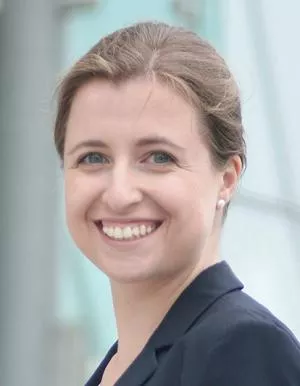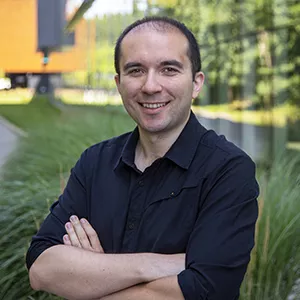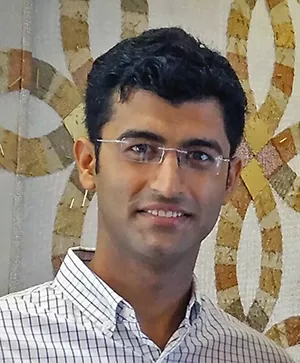Robotics research bursts onto the scene at UTM

If you hear the sound of 1,000 hands clapping at U of T Mississauga, there’s always the chance that they’ll be attached to robotic arms.
UTM has begun forging a robotics research and teaching cluster that will “take robotics to the next level,” says Jessica Burgner-Kahrs, an associate professor of computer science and expert in continuum robotics, and the de facto leader of the cluster given her research and teaching experience at Leibniz University Hannover in Germany.
“With the great resources and the support we have, great research can flow from here,” she says. “We’re building a research program and creating a whole academic program from scratch.”

The “we” to which Burgner-Kahrs refers includes her two colleagues, both assistant professors: Florian Shkurti, who joined the faculty last December after earning his PhD at McGill University, and Animesh Garg, who arrives this summer from Stanford University via a job in the robotics industry.
The three faculty members are simply the start of the cluster; UTM plans to add between two and four additional faculty to the group. In addition, the cluster is an integral part of the University of Toronto’s new Robotics Institute, billed as “U of T’s hub for multidisciplinary robotics research and innovation, home to the most diversified robotics program in Canada.” Its current member researchers hail from computer science, various engineering disciplines, aerospace and the Toronto Rehabilitation Institute.
“The institute links us so that we have a unified presence on campus and beyond,” says Shkurti. “We are the largest robotics institute in Canada and we have really ambitious plans.
“We now have a broad network of collaborators, which will allow us to create joint funding proposals. The gears are turning.”

First things first, however, and that means ensuring that research labs are functioning. Burgner-Kahrs relocated her lab to UTM from Germany to continue her groundbreaking work in continuum robotics. The robots she creates and builds from scratch are flexible, with no joints, and they can be as microscopic as one millimetre in diameter. Her personal interest is in medical applications – microsurgery, for example, where a surgeon’s hands are too large to perform the delicate tasks required – but she envisions people also using them to inspect the guts of a machine or to snake through rubble after an earthquake to find survivors. All of these tasks require communication between the humans in charge and the robots, as well as a thorough understanding of the movements required to execute the necessary tasks and the ability to craft the appropriate algorithms.
“For all of these tasks, we are busy answering the fundamental questions that will make them possible,” Burgner-Kahrs says. “We are at the frontier of something new.”
Her colleagues, too, are breaking new ground, albeit with more traditional robots. Shkurti works with imitation learning, a subset of machine learning that explores how robots can learn effectively from humans, replicating the movements after seeing a demonstration without needing to have it repeated time and time again and understanding what to do in specific situations as they arise.
“I’m developing fundamental algorithms for learning, control and computer vision to allow easy collaboration between humans and robots,” Shkurti says. “How do robots understand why humans are showing them certain actions and how can they replicate these actions? I want to make it easier for humans to specify what they want by demonstrating it, not by writing code. This makes robotics accessible to a wider audience.”
For example, robots can be trained to work with divers at coral reefs, searching for a specific type of coral underwater and recording the necessary scientific data that the diver seeks.
Garg, too, is interested in imitation guided reinforcement learning, teaching robots to “watch” a How-To video and learn how to understand a task and execute it in a given, potentially new, context.
“My work mixes computer vision with reinforcement learning and traditional control,” he says.
Garg has identified several important applications for his research: material handling, where corporations with huge warehouse operations need “workers” to fetch, pick, pack and ship products; assembly, where pieces of a product made overseas are shipped to Canada and assembled there to avoid duties; and conventional surgery, “where there is a very fixed checklist of tasks that are repetitive and monotonous.
“These applications all have a key thread: how robot hands manipulate objects the same way we do,” Garg says. “I’m not interested in replacing humans. I think of robots as the new tools; the technology embeds itself in these devices. I want to simplify complicated processes.”
The three faculty members, founding members of UTM’s robotics cluster, see a lot of commonalities and opportunities for collaboration in their work.
“All of us work at both the fundamental level of algorithm design and the application level with robots in action, both indoors and outdoors,” Shkurti says. “There are research threads connecting all of us and I envision us collaborating on fundamental research in robot control.”
Each of them is also excited about the possibilities at hand.
“The administration has been proactive about making UTM into a powerhouse in robotics,” Garg says. “The faculty is positioned for creating a critical mass of researchers. For me, it felt like a no-brainer to come here.”



